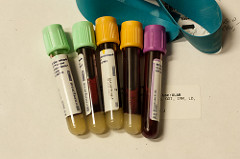Imagine a world where a simple DNA blood test could be used to identify lung cancer mutations in patients. Now, thanks to an international group of researchers, we are now one step closer to that world.
Cancer is the collection of diseases involving the continuous proliferation of body cells. This abnormal cell growth often times leads to the growth of tumors in the body. In the case of lung cancer, these tumors manifest in lung tissue. About 85% to 90% of lung cancers fall into the category of non-small cell lung cancer (NSCLC), and approximately one in ten NSCLC patients have epidermal growth factor receptor (EGFR) mutations. These mutations lead to hyperactivity and uncontrolled cell division. Since cancer treatments and therapies often target specific cancer mutations, doctors often perform tumor biopsies to test for genetic mutations such as EGFR in the cancer tissue. Unfortunately, the cancer tissue isn’t always available for doctors. Lung tumor biopsies pose risks such as partial lung collapse, respiratory failure, and breathing. Thus, for patients at higher risk for complications, lung tumor biopsies are not always recommended, rendering these patients unable to receive specialized care. Luckily, that’s where this international group of researchers comes in.
Image Source: Science Photo Library – SCIEPRO
The researchers’ study, titled ASSESS, compared the use of blood testing to detect EGFR mutations with current tissue-testing methods such as CT-guided biopsies (shown in the image above) and bronchoscopies. The study included 1162 tissue and blood samples. An analysis of the data revealed that 89% of the time, the blood and tissue tests agreed. Furthermore, plasma testing was able to identify approximately half of the patients with EFGR mutations. This is particularly significant, because not only does the study confirm the presence of EGFR mutations in DNA circulating in the bloodstream, but it also provides another method of testing for EFGR mutations that doesn’t involve removing tumor tissue. This opens up new opportunities for patients that are unable to have a tumor tissue test to receive the properly tailored treatment needed. Furthermore, this study paves the way for simpler, less invasive tests. Perhaps in the future, the medical community may be using bronchoscopies and CT-guided biopsies for less-invasive DNA blood testing.
Feature Image Source: My October blood test by Phillip Jeffrey










